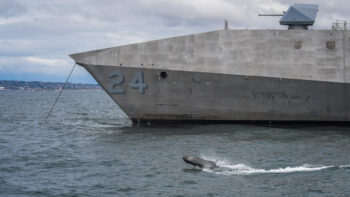WASHINGTON — A group of experts may have found a paradoxical bright side to decades of European under-investment in defense.
Since NATO doesn’t have huge sunk costs in a globe-spanning command-and-control system built on legacy tech, as the US does, it has fewer barriers to embracing the kind of cutting-edge, off-the-shelf technology that’s proven so effective in Ukraine, from commercial satellites to crowdsourced intelligence to data-sharing.
“We have a legacy force that needs to be brought forward,” said James “Hoss” Cartwright, a former vice-chairman of the joint chiefs of staff and member of the Atlantic Council board. “You can’t just say, you know, wave your hand and it’s all of a sudden digital. It doesn’t work that way. That is tens of billions of dollars [and] probably ten years to do it effectively.”
“In Europe, there’s not a lot of legacy there,” Cartwright argued, “so you’re going to be able to integrate this relatively quickly in comparison to the United States.”
“NATO might have a leg up on the US … not being tied to our legacy environments,” agreed a senior engineer from RAND’s Project Air Force, Sherrill Lingel. Even in the US Air Force — which has led the drive for the interservice meta-network known as Joint All-Domain Command & Control (aka JADC2) — “we have an industrial-age architecture; we have stove pipes; we have person-in-the-loop for most steps,” she said, as opposed to seamless, automated sharing of data.
RELATED: Pentagon boosts spending on R&D, JADC2 and cybersecurity in $145B budget
A historical analogy comes to mind: After World War I, Germany was largely disarmed, stripped in particular of tanks and combat aircraft. So when it finally shed the Versailles restrictions and rearmed, German weapons and — even more important — military thinking were markedly more modern than French and British forces encumbered by old ideas and hardware.
So how might Europe leap ahead? Some of the answers could lie in the study Cartwright and Lingel were at the Atlantic Council Thursday to discuss, written by Gordon Davis, a retired two-star US Army general and former NATO official.
Both the US and NATO, Davis said, have embraced the concept of Multi-Domain Operations: high-speed coordination among forces across the domains of air, land, sea, space, and cyberspace. But such ops are more than just a concept, Davis argued Thursday.
“They’re here. It’s now. It’s not something for the future,” he said. “We’re seeing that [conducted] by a much smaller, creative, courageous, committed force within Ukraine, against the barbaric incompetence and the mass of the Russian onslaught.”
While Russia has struggled to coordinate basic combined-arms tactics, let alone synchronize its cyber attacks with physical offensives, Ukraine has improvised at least some elements of a multi-domain command-and-control system.
“Ukrainian forces have effectively targeted and engaged Russian land and maritime forces using limited multi-source intelligence, aerial drones, maneuver and fires units, and commercial space-based open-source intelligence (OSINT) services from a variety of private companies,” Davis wrote in his report. Ukraine has adopted digital networks that match Russian targets to Ukrainian artillery much as Uber matches riders to drivers, he explained, such as GIS Arta. Combines data from drones, ground-based radars, rangefinders, and more, he wrote, GIS Arta’s “rapid calculation of firing options and alerting of firing units has cut the [Ukrainian] military’s targeting time from twenty minutes to one.”
Another recently announced system, called Delta, pools data on Russian forces from traditional classified intelligence sources, publicly available open-source intelligence, and even “crowd-sourced social media,” Davis said. “It’s available on laptops, and iPhones, smartphones and computers — not just on the safe, dry command and control headquarters, kilometers away from the battlefield.”
That decentralization and democratization of data — giving near-instant access to frontline “trigger pullers,” not just staff officers — is crucial, Cartwright said: “What’s fundamentally different in in in Ukraine right now is it’s gone directly from the top to all the nodes simultaneously — and any one of those nodes is capable of independent action.”
RELATED: SpaceX didn’t intend that Starlink be ‘weaponized’ by Ukraine: Shotwell
Much of this technology comes straight from the commercial world. “Private industry has had an incredible role,” said Davis.
SpaceX’s satellite communications network, Starlink, is the most high-profile example — especially once SpaceX cut back services it feared were being “weaponized” — but there are many others. Microsoft cybersecurity teams defend both Ukrainian and NATO networks, Davis wrote, while “private companies like Maxar, BlackSky, and Planet (imagery) and HawkEye 360 (signals) are providing AI-enabled space-based services to Ukraine and NATO allies.”
A common thread through all these efforts: Ukraine and NATO — and maybe even the US — lack the time and money to create a new system from whole cloth. Instead, the approach is more like “making… a quilt,” said RAND’s Lingel, “where you’re stitching together different sources of information…tapping into things like air traffic control radars, air surveillance radars from host nations, commercial space-based capabilities.”
Now, it’s dangerous to extrapolate too far from any one case, Cartwright cautioned. The “narrow” specifics of Ukraine don’t necessarily “apply our full range of military requirements and operations” in the US, he said, and important facts are still obscured by the fog of an ongoing war.
But his biggest takeaway is that – messy, improvisational, and ad hoc as it may be — the crazy-quilt approach to coordinating combat seems to work: “I will take a democratic approach to warfare over an autocratic [one] anytime.”























